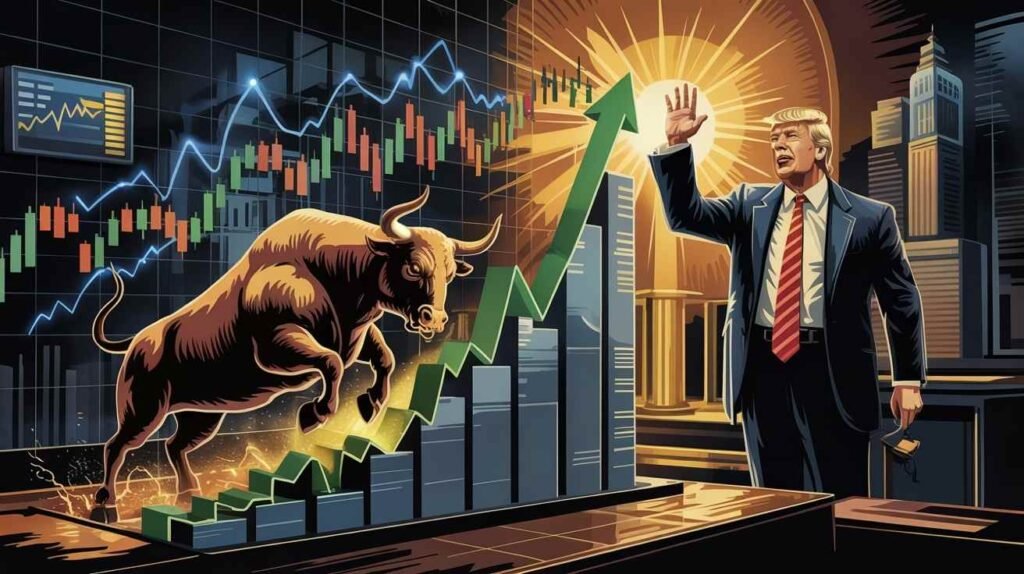
Last night I was reviewing market charts with my second cup of coffee when my phone started blowing up with notifications. The CPI numbers had just dropped, and despite beating expectations (2.4% vs anticipated 2.5%), the markets were still bleeding red. This disconnect immediately caught my attention because normally, positive inflation data sends markets climbing.
So what’s really going on here? Why are markets down nearly 3% on good inflation news? And more importantly, should we take President Trump at his word when he suggests “more great days are coming” for the markets?
Let’s dig into what’s happening beneath the surface, because I think there’s a fascinating market psychology story unfolding right before our eyes.
The CPI Beat That Nobody Cared About
First, let’s talk about those inflation numbers. We got 2.4% inflation against the 2.5% estimate – technically a “beat” by Wall Street standards. Even more encouraging is the trend: we’ve gone from 3% to 2.8% to 2.4% in consecutive readings, showing that disinflation is gaining momentum.
What makes this particularly interesting to me is that alternative inflation gauges like Trueflation are showing even lower numbers – around 1.34% and rapidly declining. When I combine this with falling oil prices (a major CPI input), all signs point toward inflation approaching the Fed’s 2% target faster than most analysts expected.
So why the market selloff? I believe we’re seeing a classic case of “buy the rumor, sell the news” combined with some profit-taking after yesterday’s historic rally. Remember, the S&P jumped nearly 10% yesterday – one of the largest single-day gains in history. Some pullback was inevitable.
But there’s something deeper happening here that ties directly to Trump’s economic strategy.
The Art of the Deal or Tactical Retreat?
The White House is pushing a narrative that this week’s tariff adjustments were all part of the “Art of the Deal” – a brilliant tactical move in a broader economic chess match. But after spending years analyzing market reactions to policy shifts, I’m seeing something different.
What I believe we witnessed was a real-time course correction. When markets crashed after the initial tariff announcements, the 10-year Treasury yield didn’t respond as expected. Instead of bringing rates down (which would have supported the administration’s goals), the policy created market chaos without achieving its intended effect.
As Trump himself candidly admitted when pressed by reporters: “You have to have flexibility… Sometimes you have to go under the wall, around the wall, or over the wall.”
Translation: They tried something, it didn’t work, and they pivoted. Quickly.
This is actually something I respect. In my own trading, I’ve learned that stubbornly sticking to failed strategies is the fastest way to blow up your account. Being nimble enough to change course when the data doesn’t support your thesis is crucial.
The market seems to be processing this reality, which partially explains why we’re not seeing continued upward momentum despite the positive inflation data.
Is This a 90-Day Market Pump?
Here’s my read on the situation: Trump’s administration has essentially called a 90-day timeout on their most aggressive tariff plans. During this period, I expect them to:
- Allow markets to recover from the sharp correction (which hit about 21% at its worst)
- Begin very public negotiations with China and other trading partners
- Use the threat of production moving to other countries (Vietnam, India, etc.) as leverage
- Position themselves for either a revised tariff approach or a “deal” that can be framed as a win
I’ve been studying market cycles long enough to know that when the President of the United States says “more great days are coming” for the markets, it’s not something to dismiss lightly. It reminds me of December 2018, when Trump called it “a tremendous opportunity to buy” stocks during a downturn. The market bottomed that very day and began a significant uptrend.
When the person who controls fiscal policy, trade agreements, and regulatory direction tells you to buy, history suggests you should probably listen.
But here’s where it gets interesting…
Bull Trap or Generational Buying Opportunity?
Looking at market history, some of the biggest single-day rallies like we just experienced have occurred during bear markets. Many of yesterday’s market moves have the classic fingerprints of a short squeeze – a violent upward move fueled by short sellers covering their positions rather than new bullish conviction.
That said, I’m seeing several technical indicators that suggest we could have further upside:
- RSI levels on major indices had reached extremely oversold conditions similar to previous bottoms
- The dollar index (DXY) is weakening, which typically supports risk assets
- We’ve already experienced a 21% correction, which is substantial by historical standards outside of major recessions
What I believe markets haven’t fully priced in yet is the possibility of a U.S.-China trade agreement. If the administration announces meetings with Chinese officials in the coming weeks (watch carefully for where these meetings take place – the location itself will be a signal about which side has the upper hand), we could see another significant market rally.
My Current Investment Approach
Given this analysis, I’ve started buying the dip more aggressively, but with a measured approach. I’m focusing primarily on:
- High-quality stocks that were unfairly punished in the recent selloff
- Strategic cryptocurrency positions, particularly in projects with strong fundamentals
- Maintaining sufficient cash reserves in case this bounce proves temporary
For crypto specifically, I found it interesting that Babylon Chain launched today at an $890 million fully diluted valuation – far below the multi-billion dollar expectations. This reflects the current cautious market sentiment, but potentially creates opportunity for those with a longer time horizon.
The Chess Game Continues
What fascinates me about the current market environment is watching this economic chess match unfold in real time. The U.S. administration is using short-term market pressure to achieve longer-term strategic objectives. China is calculating its responses carefully, aware that time may not be on their side as supply chains potentially shift to other countries.
In negotiations like these, perception becomes reality. Watch for announcements about deals with Vietnam, India, or other manufacturing hubs – these will be deliberate signals to China that the U.S. has alternatives.
My Take on What Happens Next
After analyzing the technicals, sentiment indicators, and policy signals, here’s my prediction:
- We’ll likely see choppy markets for the next week as the dust settles
- Within 2-3 weeks, we’ll hear announcements about U.S.-China trade discussions
- These announcements will trigger another leg up in both traditional markets and crypto
- The administration will use this reprieve to refine their approach before potentially reintroducing adjusted tariff policies
This doesn’t mean we’re out of the woods completely. What we may be experiencing is a bear market rally – but bear market rallies can last for weeks or even months, providing ample trading opportunities.
The key is staying flexible, watching for policy shifts, and not getting caught up in the day-to-day noise.
I’ve been through enough market cycles to know that times like these – periods of extreme volatility and uncertainty – often create the best opportunities for those willing to take calculated risks while others remain paralyzed by fear or confusion.
So am I buying this dip? Yes, selectively. Do I believe Trump when he says more good days are ahead? The market history suggests it would be foolish not to take such statements seriously.
What about you? Are you seeing this as a buying opportunity or preparing for more downside? I’d love to hear your thoughts in the comments below.
Remember, markets may be complicated, but successful investing doesn’t have to be. Stay nimble, think independently, and always match your strategy to the current market environment rather than forcing the market to fit your preferred narrative.



